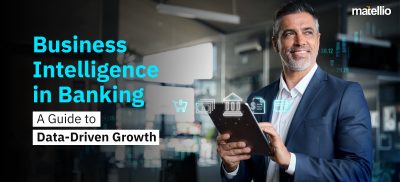
In the evolving landscape of commercial banking, the role of data and analytics has grown immensely. As financial institutions face increased competition, regulatory challenges, and the demand for personalized services, the ability to make informed decisions through analytics is crucial. Commercial banking analytics enables banks to transform raw data into actionable insights, driving strategic decisions that can enhance efficiency, mitigate risks, and improve customer satisfaction.
It involves the use of advanced data processing techniques, including predictive modeling, machine learning, and statistical analysis, to assess and improve various banking operations. From optimizing loan portfolios to detecting fraud, analytics is the backbone of modern banking strategies.
Core Components of Commercial Banking Analytics
Data Collection and Management
- Types of Data: Commercial banking analytics relies on various data types, including transactional data, customer demographics, and external economic indicators.
- Data Quality and Governance: High-quality data is essential for accurate analytics. Implementing robust data governance policies ensures the reliability and accuracy of the data used.
Also Read: Banking Analytics Solutions: Transforming Financial Services with Data-Driven Insights
Analytical Models and Techniques
- Predictive Modeling: Predictive models forecast future outcomes based on historical data, helping banks make proactive decisions.
- Machine Learning and AI: These technologies enhance the accuracy of predictions and automate complex analysis tasks.
- Credit Scoring and Risk Assessment Models: These models evaluate the creditworthiness of clients, guiding lending decisions.
Visualization and Reporting
- Data Visualization Tools: Visualization tools like dashboards present complex data in a comprehensible format, enabling quick decision-making.
- Reporting: Regular reports on KPIs and other metrics help banks monitor their performance and adjust strategies as needed.
Benefits of Implementing Analytics in Commercial Banking
 Proactive Risk Identification
Proactive Risk Identification
Analytics for banking allows the assessment of many risk factors, including credit risk, market risk, and operational risk, by leveraging historical data and predictive models. This proactive approach enables banks to foresee potential challenges, such as economic downturns or shifts in market trends, and take necessary steps to mitigate these risks before they impact the bank’s bottom line.
 Portfolio Optimization
Portfolio Optimization
Through the application of analytics, banks can optimize their loan portfolios by balancing high-risk and low-risk investments. This ensures a more stable return on investment while minimizing the likelihood of defaults.
 Personalized Services
Personalized Services
Analytics in banking provides deep insights into customer behaviors, preferences, and financial needs. By understanding these aspects, banks can tailor their products and services to meet the specific needs of individual customers, leading to a more personalized and satisfying banking experience. For instance, targeted product recommendations and customized financial advice can significantly enhance customer engagement.
 Real-Time Customer Support
Real-Time Customer Support
With analytics, banks can offer real-time support by predicting customer needs and addressing them proactively. For example, if a customer frequently checks their mortgage rates, the bank can offer a customized mortgage solution before the customer even requests it.
 Streamlined Operations
Streamlined Operations
Commercial banking Analytics helps in identifying inefficiencies within banking processes, such as lengthy loan approval times or high transaction costs. By analyzing these pain points, banks can streamline their operations, reduce bottlenecks, and improve overall workflow. This leads to faster service delivery and reduces operational costs.
 Optimized Resource Allocation
Optimized Resource Allocation
By understanding customer demand patterns and internal process efficiency, banks can allocate resources more effectively. For example, analytics can help in determining the optimal number of staff required during peak hours or the best allocation of IT resources to support digital banking platforms.
 Data-Driven Strategies
Data-Driven Strategies
By leveraging the right data consultation services, you can get advanced analytical models and executives can make more informed decisions. Whether it’s about launching a new product, entering a new market, or adjusting interest rates, data-driven insights ensure that decisions are aligned with market realities and customer needs.
 Scenario Analysis
Scenario Analysis
Analytics allows banks to simulate various market scenarios and assess their potential impact on the bank’s performance. This capability enables banks to prepare for different outcomes and make strategic decisions that safeguard their interests.
 Behavioral Profiling
Behavioral Profiling
Analytics for commercial banking enables the development of detailed behavioral profiles of their customers. By understanding the normal behavior for each customer, banks can more easily spot deviations that might indicate fraudulent actions, allowing for quicker response times.
 Innovation and Differentiation
Innovation and Differentiation
Banks that leverage analytics effectively can innovate more rapidly and offer products more closely aligned with customer needs. This ability to anticipate market trends and customer demands gives them a significant competitive edge over rivals who rely on traditional methods.
Market Leadership
By using analytics in banking, you can optimize every aspect of the operations, from customer service to risk management, you can position yourself as a leader in the market. This reputation for efficiency and customer-centricity not only attracts more customers but also fosters loyalty among existing ones.
Application of Analytics in Commercial Banking
Analytics is deeply embedded in the operations of commercial banks, transforming various aspects of the business. Here are some key applications:
Credit Risk Management
- Credit Scoring: Custom-built analytics solutions for banking are used to evaluate the creditworthiness of borrowers by analyzing factors such as payment history, income level, and current debts. This helps banks make informed lending decisions and reduce the risk of defaults.
- Loan Portfolio Optimization: By analyzing historical data and market trends, banks can optimize their loan portfolios to balance risk and return.
Customer Relationship Management (CRM)
- Personalized Marketing: You can leverage customer data analytics in commercial banking to tailor marketing campaigns based on individual customer profiles, enhancing engagement and conversion rates.
- Customer Segmentation: Analytics helps in categorizing customers into segments based on their behaviors, preferences, and needs, allowing for more targeted and effective service delivery.
Read More: Discover the power of banking CRM software development to enhance customer relationships and drive financial growth in the digital age.
Fraud Detection and Prevention
- Anomaly Detection: Machine learning algorithms are applied to transaction data to identify unusual patterns that may indicate fraudulent activities. Real-time monitoring allows for quick responses to potential threats.
- Behavioral Analytics: By analyzing customer behaviors and transaction histories, banks can detect deviations from normal patterns that may signal fraudulent actions.
Also Read: Unlocking the Power of Fraud Analytics in Banking: A Comprehensive Guide
Regulatory Compliance
- Automated Reporting: Analytics tools streamline the process of generating regulatory reports, ensuring accuracy and timeliness. This reduces the risk of non-compliance and penalties.
- Risk Reporting: Banks use analytics to assess and report on various types of risks, including market, credit, and operational risks, meeting regulatory requirements.
Operational Efficiency
- Process Optimization: Analytics identifies inefficiencies in banking operations, such as bottlenecks in loan processing or high transaction costs, enabling banks to streamline workflows and improve productivity.
- Resource Allocation: By analyzing workload and customer demand, banks can optimize resource allocation, ensuring that the right number of staff and technology are available to meet customer needs.
Investment and Portfolio Management
- Predictive Analytics: Banks use predictive models to forecast market trends, assess the performance of investment portfolios, and make informed decisions about asset allocation.
- Risk Mitigation: Analytics helps in identifying potential risks in investment portfolios and suggests strategies to mitigate them, ensuring better returns and stability.
Product and Service Innovation
- Market Trend Analysis: Banks apply analytics to identify emerging market trends and customer needs, driving the development of new financial products and services that meet evolving demands.
- Customer Feedback Analysis: By analyzing feedback from various channels, banks can refine existing products and introduce new offerings that resonate with customers.
Pricing Strategies
- Dynamic Pricing Models: Analytics allows banks to develop dynamic pricing strategies for loans, mortgages, and other products based on market conditions, competition, and customer risk profiles.
- Profitability Analysis: By analyzing cost structures and revenue streams, banks can set prices that maximize profitability while remaining competitive.
Challenges and Considerations in Commercial Banking Analytics
Data Privacy and Regulatory Compliance
- Challenge: Ensuring compliance with regulations like GDPR while using customer data for analytics.
- Consideration: Implement robust data encryption and anonymization techniques to protect customer data and ensure compliance. Regular audits are essential to maintain adherence to regulations.
Integration with Legacy Systems
- Challenge: Many banks rely on outdated systems, making it difficult to integrate modern analytics tools.
- Consideration: Gradually upgrade legacy systems or use middleware, with the support of digital transformation services, to allow new analytics tools to interface with old systems, ensuring a smooth transition without disrupting operations.
Talent and Skill Gaps
- Challenge: There is a shortage of specialized skills in data analytics, such as data science and machine learning.
- Consideration: Invest in training programs to upskill existing employees or partner with analytics experts to bridge the talent gap and accelerate analytics initiatives.
Also Read: Data Analytics in Commercial Banking: Revolutionizing Decision-Making and Efficiency
Managing Data Quality
- Challenge: Inconsistent or inaccurate data can lead to incorrect analytics outcomes.
- Consideration: Establish strict data governance policies and conduct regular audits to maintain data integrity and accuracy, ensuring reliable insights from analytics efforts.
Cost and Resource Allocation
- Challenge: Implementing analytics solutions can be costly and resource intensive.
- Consideration: Adopt a phased implementation plan, prioritizing the most critical analytics capabilities first. Consider cloud-based solutions for scalability and cost-efficiency, spreading out expenses over time.
Beat These Challenges by Custom-Building Commercial Banking Analytics Solutions!
Contact Us Now!
Future Trends in Commercial Banking Analytics
AI-Powered Automation
- Transforming Routine Processes: The application of AI in commercial banking is revolutionizing how routine tasks are handled. Activities like loan approvals, credit scoring, and customer service inquiries, which traditionally required significant manual effort, are now being automated by leveraging AI integration services. This automation not only speeds up these processes but also ensures greater accuracy and consistency.
- Focus on Complex Decision-Making: As AI takes over routine tasks, human staff are freed to concentrate on more complex and strategic activities. For instance, while AI can efficiently handle transaction monitoring for fraud detection, human analysts can focus on investigating flagged anomalies and making nuanced decisions based on broader contextual understanding.
Real-Time Analytics
- Instant Decision-Making: The demand for real-time analytics in commercial banking is growing rapidly. Banks are increasingly utilizing real-time data processing to make instant decisions, which is particularly critical in areas like fraud detection and customer service. For example, real-time analytics can identify suspicious transactions as they occur, allowing for immediate intervention to prevent fraud.
- Enhanced Customer Interaction: Real-time analytics also enhances customer interactions by enabling banks to respond promptly to customer needs. Whether it’s adjusting a loan offer based on real-time credit scoring or providing instant feedback on a service inquiry, the ability to process and act on data instantly is becoming a key differentiator in customer satisfaction.
Predictive Analytics
- More Accurate Forecasting: Predictive analytics for commercial banking is evolving to provide more accurate and reliable forecasts of market trends, customer behavior, and potential risks. By leveraging advanced algorithms and larger datasets, banks can now predict future events with greater precision, allowing them to prepare and respond proactively.
- Strategic Planning: Enhanced predictive models also empowering banks to plan their strategies more effectively. For example, predictive analytics can forecast economic downturns, enabling banks to adjust their risk exposure or capital reserves. Similarly, predicting customer churn can help banks develop retention strategies before losing valuable clients.
Cloud-Based Analytics
- Scalability and Flexibility: The shift towards cloud computing is one of the most significant trends in commercial banking analytics. Cloud-based analytics platforms offer scalability, which helps banks to handle large volumes of data as their operations grow. This scalability is particularly important for global banks that deal with massive datasets across different regions and markets.
- Enhanced Collaboration: Cloud computing facilitates better collaboration across different departments and locations by providing centralized access to data and analytics tools. This promotes more cohesive and integrated decision-making processes within the bank.
Open Banking and Data Sharing
- Expanded Analytics Capabilities: The rise of open banking is encouraging data sharing between financial institutions, which in turn is expanding the scope and effectiveness of analytics. Open banking APIs allow banks to access and share customer data (with consent), enabling more comprehensive analytics that can lead to better financial products and services.
- Enhanced Customer Offerings: Data sharing through open banking facilitates the development of more innovative and competitive services. For example, by aggregating data from multiple banks, financial institutions can offer customers a consolidated view of their finances, along with personalized recommendations and insights based on a more holistic understanding of their financial situation.
- Increased Competition and Innovation: Open banking is driving competition among banks, pushing them to innovate and improve their offerings. Banks that effectively leverage data sharing can gain a competitive edge by providing superior analytics-driven products and services that better meet customer needs.
Also Read: Unlock the power of Business Intelligence in Banking to drive data-driven decisions, optimize operations, and enhance customer experiences with actionable insights.
Explore How These Trends Can Enhance Your Business!
Connect With Us!
Steps for Development Commercial Banking Analytics Solution
 Assessing Current Capabilities
Assessing Current Capabilities
Evaluate the existing data infrastructure, analytics tools, and skill levels within the organization to understand current capabilities. Our experts can conduct a thorough audit of your current systems, identifying gaps and opportunities for improvement and providing you with ideas about which features or tools to consider while developing your commercial banking analytics solution.
 Defining Clear Objectives
Defining Clear Objectives
Align analytics initiatives with the bank’s strategic objectives, such as enhancing customer experience, reducing risks, or improving operational efficiency. Our experts can help you define and prioritize clear, measurable objectives that align with your business goals.
 Building the Right Team
Building the Right Team
Now it’s time to assemble a team with the necessary skills in data science, analytics, and financial services to execute your analytics strategy. But building a team can be a hassle and impact your project timeline and cost. On the other hand, if you choose us, we will provide you with a team of experts who are already trained and have experience in developing commercial banking analytics solutions.
 Choosing the Right Tools
Choosing the Right Tools
Select analytics platforms and tools that are best suited to your bank’s needs, considering factors like scalability, ease of use, and integration capabilities. Our experts can guide you in choosing the right tools by offering technology consulting services. It ensures that you wisely decide what tool you wish to integrate and what to custom-build for your existing systems.
 Continuous Monitoring and Improvement
Continuous Monitoring and Improvement
Lastly it is vital to establish a feedback loop to continuously monitor the performance of analytics initiatives and make data-driven improvements. We offer ongoing support and analytics expertise to help you refine your strategy and stay ahead of industry trends.
Want To Develop a Commercial Banking Analytics Solution?
Fill Out the Form!
How Can Matellio Help with Commercial Banking Analytics?
Commercial banking analytics is crucial for improving decision-making, enhancing customer experience, and driving operational efficiency. Implementing advanced analytics solutions can significantly elevate your bank’s ability to leverage data for strategic insights and competitive advantage.
Here are some key areas where choosing us can be beneficial:
- Our expertise in implementing comprehensive data analytics frameworks allows your bank to harness vast amounts of data, transforming it into actionable insights. This enables more informed decision-making, from risk management to customer relationship strategies.
- We help you seamlessly integrate advanced commercial banking analytics solutions into cloud-based environments. Our cloud integration services ensure that your analytics technology is scalable, secure, and aligned with the latest industry trends, maximizing your return on investment and enabling more flexible data management.
- Our cutting-edge AI and machine learning solutions enhance the capabilities of your commercial banking analytics systems. We help you identify patterns, predict market trends, and optimize operational processes, ensuring that your bank stays ahead in the competitive landscape.
- We provide continuous updates, performance monitoring, and troubleshooting for your analytics systems. Our dedicated support ensures that your commercial banking analytics remains efficient, up-to-date, and capable of delivering consistent value.
So, if you wish to boost your business growth, then fill out the form and reach out to our experts.
FAQ’s
Q1. Can commercial banking analytics integrate with existing systems?
Yes, our commercial banking analytics solutions are designed to integrate seamlessly with both legacy and modern systems. We offer customized solutions that ensure a smooth transition without disrupting your current operations.
Q2. What are the costs associated with implementing commercial banking analytics?
Costs vary depending on system complexity, technology needs, and integration scope. We offer transparent and detailed estimates tailored to your specific requirements, ensuring a solution that fits within your budget.
Q3. What support and maintenance do you offer for commercial banking analytics?
We provide comprehensive support, including 24/7 assistance, regular updates, performance optimization, and proactive monitoring. Our goal is to ensure your analytics systems are always running smoothly and effectively.
Q4. How is data migration handled during the implementation of commercial banking analytics?
We manage data migration with a secure and structured approach, ensuring minimal disruption. Our process includes detailed planning, testing, and the use of backup and recovery solutions to maintain data integrity.
Q5. How does Matellio ensure data security and compliance in commercial banking analytics?
We implement rigorous security measures such as encryption, access controls, and regular audits. Our focus on security and compliance ensures that your analytics systems meet all regulatory requirements while protecting sensitive information.
 Proactive Risk Identification
Proactive Risk Identification Portfolio Optimization
Portfolio Optimization Personalized Services
Personalized Services Real-Time Customer Support
Real-Time Customer Support Streamlined Operations
Streamlined Operations Optimized Resource Allocation
Optimized Resource Allocation Data-Driven Strategies
Data-Driven Strategies Scenario Analysis
Scenario Analysis Behavioral Profiling
Behavioral Profiling Innovation and Differentiation
Innovation and Differentiation
 Assessing Current Capabilities
Assessing Current Capabilities Defining Clear Objectives
Defining Clear Objectives Building the Right Team
Building the Right Team Choosing the Right Tools
Choosing the Right Tools Continuous Monitoring and Improvement
Continuous Monitoring and Improvement

